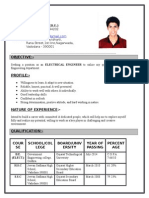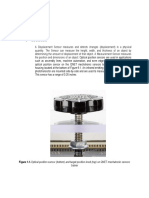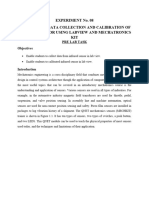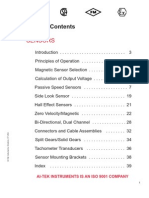MECHKIT Magnetic Field (Student)
MECHKIT Magnetic Field (Student)
Uploaded by
Alfonso Salas EnriquezCopyright:
Available Formats
MECHKIT Magnetic Field (Student)
MECHKIT Magnetic Field (Student)
Uploaded by
Alfonso Salas EnriquezCopyright
Available Formats
Share this document
Did you find this document useful?
Is this content inappropriate?
Copyright:
Available Formats
MECHKIT Magnetic Field (Student)
MECHKIT Magnetic Field (Student)
Uploaded by
Alfonso Salas EnriquezCopyright:
Available Formats
MAGNETIC FIELD
1 Background
A magnetic field transducer outputs a voltage proportional to the magnetic field that is applied to the target. The
magnetic field sensor is the chip located on the bottom of Figure 1.1. It applies a magnetic field perpendicular to the
flat screw head. The position of the screw head is changed by rotating the knob. This magnetic field transducer has
a similar range to the optical position sensor.
Figure 1.1: Magnetic field transducer on QNET Mechatronics Sensors Trainer
1.1 Magnetic Field Virtual Instrument
The virtual instrument used to collect data using the magnetic field transducer is shown in Figure 1.2. The virtual
instrument used to calibrate magnetic field data is shown in Figure 1.3.
QNET MECHATRONICS SENSORS TRAINER Workbook - Student v 1.0
Figure 1.2: Collecting magnetic field data
QNET MECHATRONICS SENSORS TRAINER Workbook - Student 2
Figure 1.3: Calibrating the magnetic field transducer
QNET MECHATRONICS SENSORS TRAINER Workbook - Student v 1.0
2 In-Lab Exercise
2.1 Collect Data
1. Ensure J8 is set to Magnetic Field.
2. Open the QNET_MECHKIT_Magnetic_Field.vi. Make sure the correct Device is chosen.
3. Run QNET_MECHKIT_Magnetic_Field.vi.
4. Gently turn the knob of the magnetic field sensor clockwise until it is at its limit. Then, rotate the knob slightly
counter-clockwise so the 0 mark on the knob faces up. This will be reference 0 inches target position. Enter
this in the Target Range (inch) array, shown in Figure 1.2.
5. Enter the voltage measured from the magnetic field position sensor for the reference 0 inch position in the
Sensor Measurement (V) array. The array is indicated in Figure 1.2.
6. Turn the knob counter-clockwise one rotation to move the target further from the sensor. The target moves
1-inch for every 20 turns. Enter the position the target has moved from the reference in the Target Range (inch)
array.
7. Record the measured sensor voltage in the Sensor Measurement (V) array.
8. Take samples for the entire range of the target (i.e. until the knob cannot be rotated CCW anymore). The
magnetic field sensor is exponential. The parameters of the exponential function are outputted and the fitted
curve is automatically plotted as data is entered.
9. Enter the range and measured sensor voltages and capture the Sensor Readings scope.
Parameter Value Units Notes
Sensor Measurement: at 0 in
Sensor Measurement: at 0.025 in
Sensor Measurement: at 0.050 in
Sensor Measurement: at 0.075 in
Sensor Measurement: at 0.100 in
Sensor Measurement: at 0.125 in
Sensor Measurement: at 0.150 in
Sensor Measurement: at 0.175 in
Sensor Measurement: at 0.200 in
Table 2.1: Magnetic field transducer results
10. Click on Stop button to stop the VI.
2.2 Calibrate Sensor
1. Run the QNET_MECHKIT_Magnetic_Field.vi.
2. Enter Gain and Damping exponential function parameters to correctly measure the distance of the target. For
instance, when target is at 0.10 inches from the reference, then the display should read 0.10 inches. What
calibration gain and damping did you obtain?
3. Click on Stop button to stop the VI.
QNET MECHATRONICS SENSORS TRAINER Workbook - Student 4
2014 Quanser Inc., All rights reserved.
Quanser Inc.
119 Spy Court
Markham, Ontario
L3R 5H6
Canada
info@quanser.com
Phone: 1-905-940-3575
Fax: 1-905-940-3576
Printed in Markham, Ontario.
For more information on the solutions Quanser Inc. offers, please visit the web site at:
http://www.quanser.com
This document and the software described in it are provided subject to a license agreement. Neither the software nor this document may be
used or copied except as specified under the terms of that license agreement. Quanser Inc. grants the following rights: a) The right to reproduce
the work, to incorporate the work into one or more collections, and to reproduce the work as incorporated in the collections, b) to create and
reproduce adaptations provided reasonable steps are taken to clearly identify the changes that were made to the original work, c) to distribute
and publically perform the work including as incorporated in collections, and d) to distribute and publicly perform adaptations. The above rights
may be exercised in all media and formats whether now known or hereafter devised. These rights are granted subject to and limited by the
following restrictions: a) You may not exercise any of the rights granted to You in above in any manner that is primarily intended for or directed
toward commercial advantage or private monetary compensation, and b) You must keep intact all copyright notices for the Work and provide the
name Quanser Inc. for attribution. These restrictions may not be waved without express prior written permission of Quanser Inc.
QNET MECHATRONICS SENSORS TRAINER Workbook - Student v 1.0
You might also like
- Laporan Praktikum Pengukuran Dan Metrologi: Departemen Teknik Mesin Universitas Indonesia Depok 2019No ratings yetLaporan Praktikum Pengukuran Dan Metrologi: Departemen Teknik Mesin Universitas Indonesia Depok 201922 pages
- Technology and Benefits of Linear Position Sensors: ProgrammableNo ratings yetTechnology and Benefits of Linear Position Sensors: Programmable6 pages
- Measurements and Metrology Laboratory Manual100% (3)Measurements and Metrology Laboratory Manual20 pages
- Deviser TV Analyser S7000: Část 2.: Praktický TestNo ratings yetDeviser TV Analyser S7000: Část 2.: Praktický Test11 pages
- Deviser TV Analyser S7000: 2. Dio: U PraksiNo ratings yetDeviser TV Analyser S7000: 2. Dio: U Praksi11 pages
- WT901BLECL Attitude Angle Sensor Specification: Update Content Author Date V1.0 Release Sharlene 20180620No ratings yetWT901BLECL Attitude Angle Sensor Specification: Update Content Author Date V1.0 Release Sharlene 2018062018 pages
- Deviser TV Analyser S7000: Bagian 2: Pengujian PraxisNo ratings yetDeviser TV Analyser S7000: Bagian 2: Pengujian Praxis11 pages
- Deviser ТВ анализатор S7000: Част 2: Тест на PraxisNo ratings yetDeviser ТВ анализатор S7000: Част 2: Тест на Praxis11 pages
- 通用电气ge Discovery Mr750 3.0t 磁共振成像系统8kw 3.0t Mns AmNo ratings yet通用电气ge Discovery Mr750 3.0t 磁共振成像系统8kw 3.0t Mns Am8 pages
- Measurement & Instrumentation BMM3532: Accelerometer'No ratings yetMeasurement & Instrumentation BMM3532: Accelerometer'4 pages
- Deviser TV Analyser S7000: Multi Norm גוסמ היזיוולט תוא חתנNo ratings yetDeviser TV Analyser S7000: Multi Norm גוסמ היזיוולט תוא חתנ11 pages
- Lab Report-06 (Mechkit) : Objective-TheoryNo ratings yetLab Report-06 (Mechkit) : Objective-Theory6 pages
- Discuss The Operation of Transferring Signals From The Broadcasting Station To Receiving StationNo ratings yetDiscuss The Operation of Transferring Signals From The Broadcasting Station To Receiving Station3 pages
- M I LAB REPORT 12 Angle Measurements Using Potentiometer of NI ELVIS II KitNo ratings yetM I LAB REPORT 12 Angle Measurements Using Potentiometer of NI ELVIS II Kit8 pages
- Experiment No: 03 EXPERIMENT: Measurement of Different Parameters of A Machine Component Using The Optical Comparator100% (1)Experiment No: 03 EXPERIMENT: Measurement of Different Parameters of A Machine Component Using The Optical Comparator7 pages
- Sahkar Maharshi Shankarrao Mohite-Patil Institute of Technology and Research, Akluj. Mechanical Engineering DepartmentNo ratings yetSahkar Maharshi Shankarrao Mohite-Patil Institute of Technology and Research, Akluj. Mechanical Engineering Department11 pages
- N30U Service Manual For Firmware From 2 00 Rev BNo ratings yetN30U Service Manual For Firmware From 2 00 Rev B52 pages
- Td8620 Handheld Digital Teslameter: User'S ManualNo ratings yetTd8620 Handheld Digital Teslameter: User'S Manual13 pages
- TD8620 Handheld Digital Gauss Meter ManualNo ratings yetTD8620 Handheld Digital Gauss Meter Manual13 pages
- LABORATORY 5. Automations Using Ultrasonic Snesor and DC Motor100% (2)LABORATORY 5. Automations Using Ultrasonic Snesor and DC Motor7 pages
- Sensor Assignment: ETSC 242 Revised Fall 2019No ratings yetSensor Assignment: ETSC 242 Revised Fall 20193 pages
- Temperature and Pressure Transmitters (Font 11) 98No ratings yetTemperature and Pressure Transmitters (Font 11) 9817 pages
- PC-4-V11-UEN-Ver10-20180411 User ManualNo ratings yetPC-4-V11-UEN-Ver10-20180411 User Manual17 pages
- ISA Certified Control Systems Technician (CCST): Certification Exam Prep: 500 Practice Exam Questions and ExplanationsFrom EverandISA Certified Control Systems Technician (CCST): Certification Exam Prep: 500 Practice Exam Questions and ExplanationsNo ratings yet
- Handbook of Microwave Component Measurements: with Advanced VNA TechniquesFrom EverandHandbook of Microwave Component Measurements: with Advanced VNA Techniques4/5 (1)
- Set-A (List of Experiments Is Not Mentioned in RGPV Curriculum) Set-BNo ratings yetSet-A (List of Experiments Is Not Mentioned in RGPV Curriculum) Set-B53 pages
- Manufacturing Process Engineer in Albuquerque NM Resume David SteeleNo ratings yetManufacturing Process Engineer in Albuquerque NM Resume David Steele4 pages
- CCDE Written Exam Topics v2.1: For Written Exams Scheduled August 30, 2018 and BeyondNo ratings yetCCDE Written Exam Topics v2.1: For Written Exams Scheduled August 30, 2018 and Beyond4 pages
- Creepage Distance For PCBs Handling Line Voltage AC - Electrical Engineering Stack ExchangeNo ratings yetCreepage Distance For PCBs Handling Line Voltage AC - Electrical Engineering Stack Exchange5 pages
- Module of Fundamental of Computer Application.No ratings yetModule of Fundamental of Computer Application.3 pages
- Koehring and Bantam Excavators 6605 Parts Book 108301100% (63)Koehring and Bantam Excavators 6605 Parts Book 1083018 pages
- Student Leave Management System: Group MembersNo ratings yetStudent Leave Management System: Group Members10 pages
- Module 5 - Combinational Logic Digital Arithmetic CircuitsNo ratings yetModule 5 - Combinational Logic Digital Arithmetic Circuits15 pages
- Mcafee Enterprise Security Manager Data Source Configuration Reference Guide 9-13-2022No ratings yetMcafee Enterprise Security Manager Data Source Configuration Reference Guide 9-13-20221,077 pages
- Company Profile: Cv. Infinite Digital SolutionNo ratings yetCompany Profile: Cv. Infinite Digital Solution31 pages
- AMT ELECTRIC ABB Pricelist 06-07-2020-1No ratings yetAMT ELECTRIC ABB Pricelist 06-07-2020-127 pages
- Hall Buttons Car Operating Panel: Standard Hall Call Button & Position IndicatorNo ratings yetHall Buttons Car Operating Panel: Standard Hall Call Button & Position Indicator1 page
- A Paperless Office Is A Work Environment in Which The Use of Paper Is Eliminated or Greatly ReducedNo ratings yetA Paperless Office Is A Work Environment in Which The Use of Paper Is Eliminated or Greatly Reduced4 pages
- Laporan Praktikum Pengukuran Dan Metrologi: Departemen Teknik Mesin Universitas Indonesia Depok 2019Laporan Praktikum Pengukuran Dan Metrologi: Departemen Teknik Mesin Universitas Indonesia Depok 2019
- Technology and Benefits of Linear Position Sensors: ProgrammableTechnology and Benefits of Linear Position Sensors: Programmable
- Deviser TV Analyser S7000: Část 2.: Praktický TestDeviser TV Analyser S7000: Část 2.: Praktický Test
- WT901BLECL Attitude Angle Sensor Specification: Update Content Author Date V1.0 Release Sharlene 20180620WT901BLECL Attitude Angle Sensor Specification: Update Content Author Date V1.0 Release Sharlene 20180620
- Deviser TV Analyser S7000: Bagian 2: Pengujian PraxisDeviser TV Analyser S7000: Bagian 2: Pengujian Praxis
- Deviser ТВ анализатор S7000: Част 2: Тест на PraxisDeviser ТВ анализатор S7000: Част 2: Тест на Praxis
- 通用电气ge Discovery Mr750 3.0t 磁共振成像系统8kw 3.0t Mns Am通用电气ge Discovery Mr750 3.0t 磁共振成像系统8kw 3.0t Mns Am
- Measurement & Instrumentation BMM3532: Accelerometer'Measurement & Instrumentation BMM3532: Accelerometer'
- Deviser TV Analyser S7000: Multi Norm גוסמ היזיוולט תוא חתנDeviser TV Analyser S7000: Multi Norm גוסמ היזיוולט תוא חתנ
- Discuss The Operation of Transferring Signals From The Broadcasting Station To Receiving StationDiscuss The Operation of Transferring Signals From The Broadcasting Station To Receiving Station
- M I LAB REPORT 12 Angle Measurements Using Potentiometer of NI ELVIS II KitM I LAB REPORT 12 Angle Measurements Using Potentiometer of NI ELVIS II Kit
- Experiment No: 03 EXPERIMENT: Measurement of Different Parameters of A Machine Component Using The Optical ComparatorExperiment No: 03 EXPERIMENT: Measurement of Different Parameters of A Machine Component Using The Optical Comparator
- Sahkar Maharshi Shankarrao Mohite-Patil Institute of Technology and Research, Akluj. Mechanical Engineering DepartmentSahkar Maharshi Shankarrao Mohite-Patil Institute of Technology and Research, Akluj. Mechanical Engineering Department
- LABORATORY 5. Automations Using Ultrasonic Snesor and DC MotorLABORATORY 5. Automations Using Ultrasonic Snesor and DC Motor
- Temperature and Pressure Transmitters (Font 11) 98Temperature and Pressure Transmitters (Font 11) 98
- ISA Certified Control Systems Technician (CCST): Certification Exam Prep: 500 Practice Exam Questions and ExplanationsFrom EverandISA Certified Control Systems Technician (CCST): Certification Exam Prep: 500 Practice Exam Questions and Explanations
- Handbook of Microwave Component Measurements: with Advanced VNA TechniquesFrom EverandHandbook of Microwave Component Measurements: with Advanced VNA Techniques
- Set-A (List of Experiments Is Not Mentioned in RGPV Curriculum) Set-BSet-A (List of Experiments Is Not Mentioned in RGPV Curriculum) Set-B
- Manufacturing Process Engineer in Albuquerque NM Resume David SteeleManufacturing Process Engineer in Albuquerque NM Resume David Steele
- CCDE Written Exam Topics v2.1: For Written Exams Scheduled August 30, 2018 and BeyondCCDE Written Exam Topics v2.1: For Written Exams Scheduled August 30, 2018 and Beyond
- Creepage Distance For PCBs Handling Line Voltage AC - Electrical Engineering Stack ExchangeCreepage Distance For PCBs Handling Line Voltage AC - Electrical Engineering Stack Exchange
- Koehring and Bantam Excavators 6605 Parts Book 108301Koehring and Bantam Excavators 6605 Parts Book 108301
- Module 5 - Combinational Logic Digital Arithmetic CircuitsModule 5 - Combinational Logic Digital Arithmetic Circuits
- Mcafee Enterprise Security Manager Data Source Configuration Reference Guide 9-13-2022Mcafee Enterprise Security Manager Data Source Configuration Reference Guide 9-13-2022
- Hall Buttons Car Operating Panel: Standard Hall Call Button & Position IndicatorHall Buttons Car Operating Panel: Standard Hall Call Button & Position Indicator
- A Paperless Office Is A Work Environment in Which The Use of Paper Is Eliminated or Greatly ReducedA Paperless Office Is A Work Environment in Which The Use of Paper Is Eliminated or Greatly Reduced

























































































